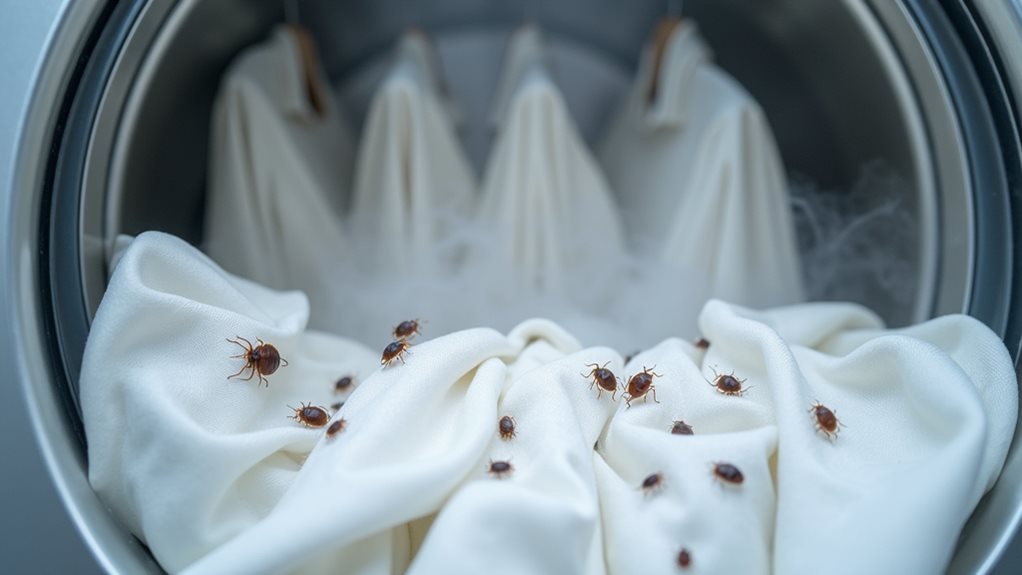Dry cleaning does kill adult bed bugs through chemical solvents like PERC and heat exposure, but here’s the frustrating reality I’ve learned from countless pest control experiences—it won’t eliminate those stubborn eggs hiding deep in fabric seams. Most dry cleaning processes don’t consistently reach the 113°F needed to destroy eggs, which means you could face reinfestation when your “clean” clothes return home, and understanding the complete picture will help you develop a more effective strategy.
Understanding Bed Bugs and Their Vulnerabilities
While most people think bed bugs are indestructible little monsters that’ll survive a nuclear apocalypse (okay, maybe that’s a slight exaggeration 😅), the truth is these persistent pests actually have some pretty considerable weaknesses you can exploit.
Understanding bed bugs and their vulnerabilities is your first step toward winning this battle, and honestly, knowledge really is power here.
Heat represents their biggest Achilles’ heel – temperatures above 113°F will kill adult bugs, while their eggs need even higher heat at 120°F. This vulnerability makes heat an effective method for eliminating infestations when applied correctly.
However, these crafty creatures can survive in countless hiding spots, which is why early detection matters so much, and why professional pest control often recommends a thorough approach combining multiple treatment strategies.
While commercial dry cleaning machines generate lethal temperatures for bed bugs, this method works best as a supplementary treatment rather than your primary elimination strategy.
How the Dry Cleaning Process Works
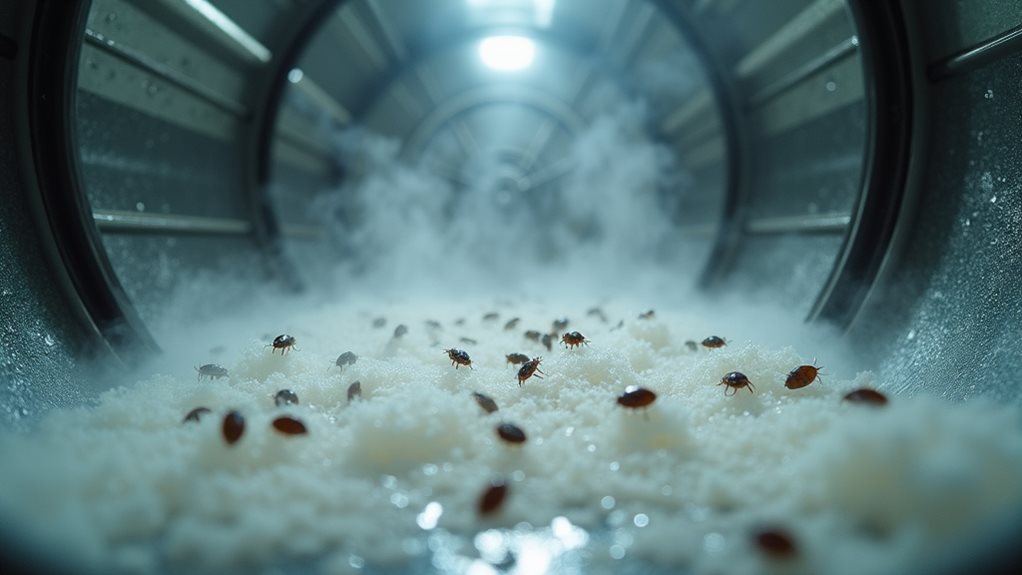
When you drop off your favorite sweater at the dry cleaner’s, you’re probably not thinking about the fascinating chemical ballet that’s about to unfold behind those swinging doors.
However, understanding this process becomes crucial when you’re dealing with a bed bug situation. The dry cleaning process relies on a chemical solvent called perchloroethylene (PERC) instead of water, which creates a hostile environment that can kill bed bugs effectively.
Here’s what happens to your infested garments:
- Chemical Treatment: PERC circulates through fabrics, providing thorough cleaning while eliminating adult bed bugs.
- High Temperatures: The cleaning cycle operates at heightened heat levels that help destroy pests.
- Warm Air Drying: Final drying further assists in elimination of bed bugs.
However, bed bug eggs hiding in seams might survive, so complete eradication isn’t always guaranteed. For the most effective results, dry cleaning should be combined with other integrated pest management strategies to ensure complete bed bug elimination.
Effectiveness of Dry Cleaning Against Bed Bugs
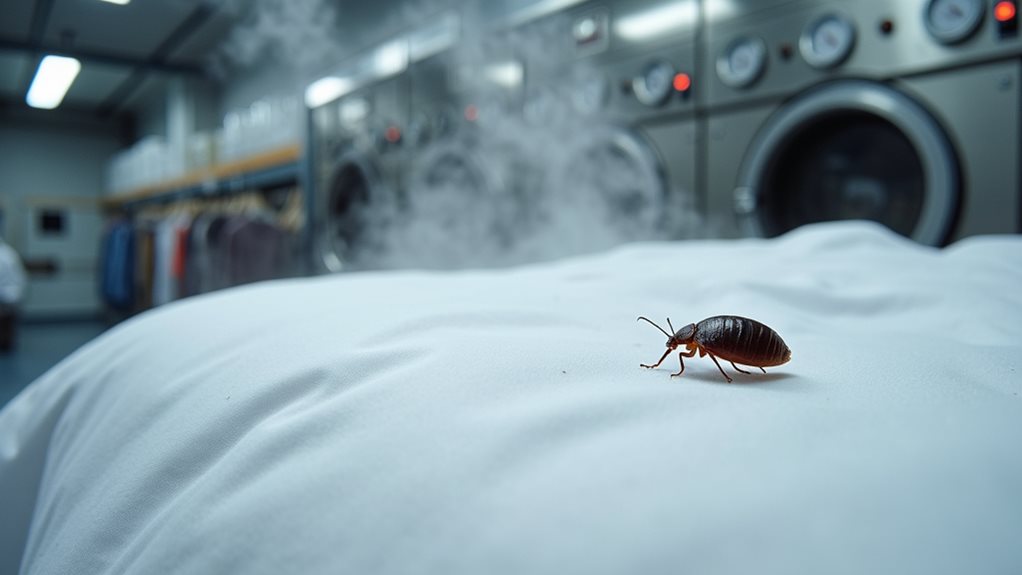
When you’re dealing with bed bugs, you’ll want to understand that dry cleaning‘s chemical solvents, particularly PERC, pack a serious punch against adult bed bugs, fundamentally suffocating them during the cleaning process.
However, here’s where things get tricky – while those chemicals work wonders on the grown-ups, they often can’t penetrate deep enough into seams and fabric crevices where bed bug eggs love to hide, leaving you with a potential re-infestation waiting to happen 😬.
The temperature factor becomes equally important because most dry cleaning processes don’t consistently reach the sustained heat levels above 113°F that you’d need to eliminate all life stages, which means you’re getting partial results rather than the complete victory you’re hoping for.
For best results, items should be properly sealed in plastic bags before transport to the dry cleaner to prevent spreading the infestation to other areas of your home or vehicle.
Chemical Solvent Impact
Since most people don’t realize what actually happens inside those mysterious dry cleaning machines, let me share what I’ve learned about the chemical warfare going on in there—and trust me, it’s more intense than you’d expect.
The chemical solvent perchloroethylene (PERC) acts like a microscopic assassin, aggressively attacking bed bugs on your infested clothing with impressive results.
Here’s what this powerhouse chemical accomplishes:
- Kills adult bed bugs on contact – PERC’s harsh properties make it effective in killing visible bugs clinging to fabric fibers.
- Damages some bed bug eggs – While not foolproof, the solvent can eliminate eggs on clothing surfaces.
- Limited deep penetration – Unfortunately, it can’t reach eggs buried in thick seams and hidden crevices.
However, the limitations of dry cleaning become apparent when you realize it’s not a thorough solution requiring high temperatures for complete extermination. The high heat exposure generated in commercial dry cleaning machines typically reaches temperatures sufficient to destroy bed bugs, making this thermal component equally important as the chemical treatment.
Temperature Treatment Limitations
While chemical solvents pack a punch against bed bugs, the temperature factor in dry cleaning reveals a frustrating gap that I discovered the hard way after assuming my expensive wool coat would emerge completely bug-free.
Here’s the reality: dry cleaning’s temperature treatment limitations create a notable weakness in the battle against these persistent pests.
Standard dry cleaning processes don’t reach the lethal threshold of 113°F needed to kill adult bed bugs consistently, and they fall even shorter of the 120°F required to eliminate eggs.
Even though perchloroethylene and other cleaning solvents work hard, the combination of insufficient heat means your garments might harbor surviving eggs that’ll hatch later, potentially triggering reinfestation when you bring those “clean” clothes back home.
Workers in dry cleaning facilities face higher exposure levels to these chemical solvents than consumers, highlighting the health risks associated with repeated exposure to traditional dry cleaning chemicals.
Temperature Requirements for Killing Bed Bugs
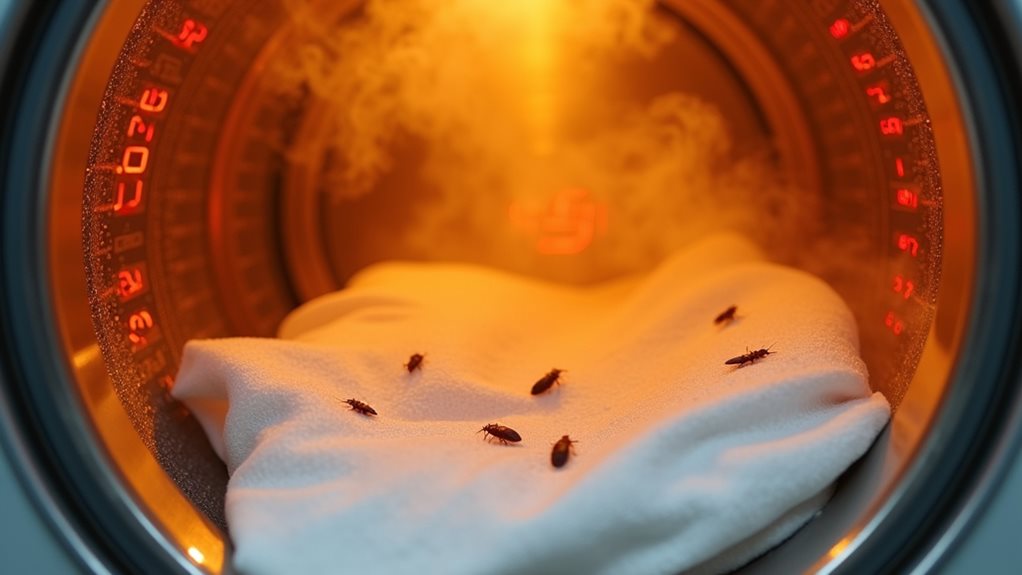
When you’re battling bed bugs, understanding the exact temperatures needed to kill these persistent pests becomes vital, since even a few degrees can mean the difference between success and continued sleepless nights.
You’ll need to reach at least 113°F to kill adult bed bugs within a minute, but their eggs require even higher temperatures of 120°F to guarantee complete elimination—trust me, I learned this the hard way after thinking I’d won the war, only to find new hatchlings a week later 😅.
While heat treatments can be remarkably effective, cold temperatures also offer some promise for killing bed bugs, though the requirements and timing differ greatly from the heat approach.
Lethal Heat Thresholds
Three key temperature thresholds determine whether you’ll successfully eliminate these persistent pests through heat treatment, and understanding these numbers can save you from the frustration I experienced when my first attempt at heat treatment failed miserably.
While dry cleaning uses extreme temperatures, it’s essential to know exactly what lethal heat thresholds actually kill bed bugs and their stubborn eggs.
Here are the vital temperatures you need to remember:
- 113°F (45°C) – Adult bed bugs begin dying after one minute of exposure
- 120°F (49°C) – Required temperature to destroy bed bug eggs completely
- 140°F (60°C) – High heat level that eradicate bed bugs when sustained for 30-90 minutes
Professional heat treatments often exceed these thresholds, while cleaning solvents work differently than pure heat exposure.
Cold Treatment Effectiveness
Have you ever wondered if your freezer could become your secret weapon against bed bugs?
Because after spending hundreds on professional treatments, I discovered that extreme cold can be just as deadly as scorching heat.
Cold treatment requires precise temperature management – you’ll need 0°F (-18°C) for four full days to kill bed bugs across all life stages, including those stubborn eggs.
Your standard home freezer might work, but rapid freezing at -17°F (-27°C) for 24 hours proves more reliable for extermination.
Unlike dry cleaning’s heat method, effective cold treatment demands complete temperature penetration through infested items, guaranteeing bugs hiding in fabric crevices can’t escape the freeze.
This approach complements traditional pest eradication methods, especially for delicate materials that can’t handle intense heat 🧊
Limitations of Dry Cleaning for Bed Bug Elimination
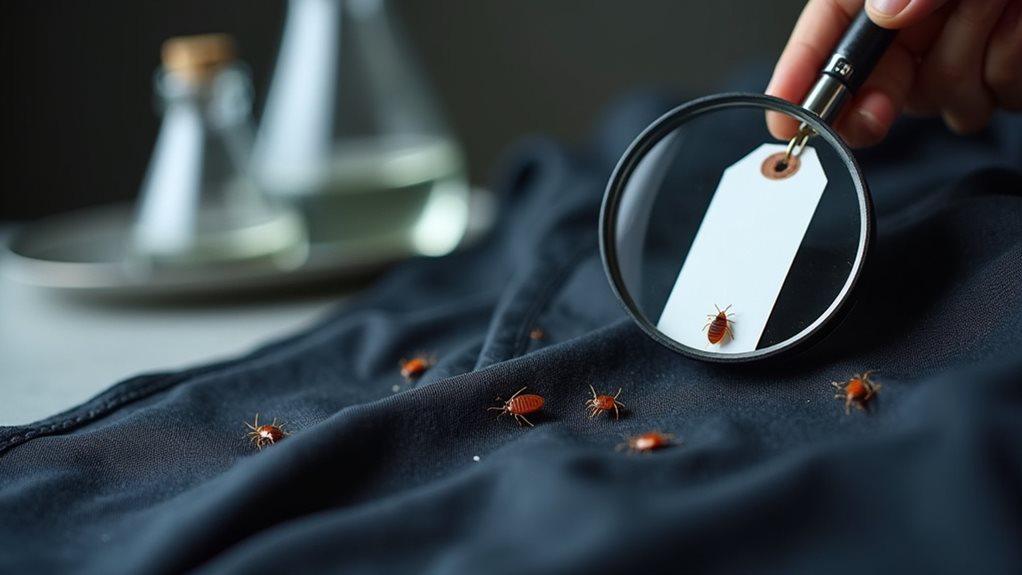
Although dry cleaning might seem like a silver bullet for your bed bug nightmare, I’ve learned through countless conversations with frustrated homeowners that it’s more like bringing a knife to a gunfight 🔪.
Dry cleaning feels like the perfect solution for bed bugs, but it’s actually bringing inadequate weapons to an intense battle.
While the chemicals used in dry cleaning can eliminate adult bed bugs, you’re dealing with some serious limitations that’ll leave you scratching your head (literally):
- Eggs survive the process – Those resilient little eggs hide deep in fabric fibers where chemicals can’t reach effectively.
- Temperature isn’t hot enough – Most dry cleaning doesn’t sustain the 113°F needed to kill these persistent pests.
- Reinfestation happens fast – You’ll bring clean clothes back into infested environments, starting the cycle again.
Trust me, dry cleaning alone won’t solve your bed bug infestations completely.
Alternative Methods for Bed Bug Control
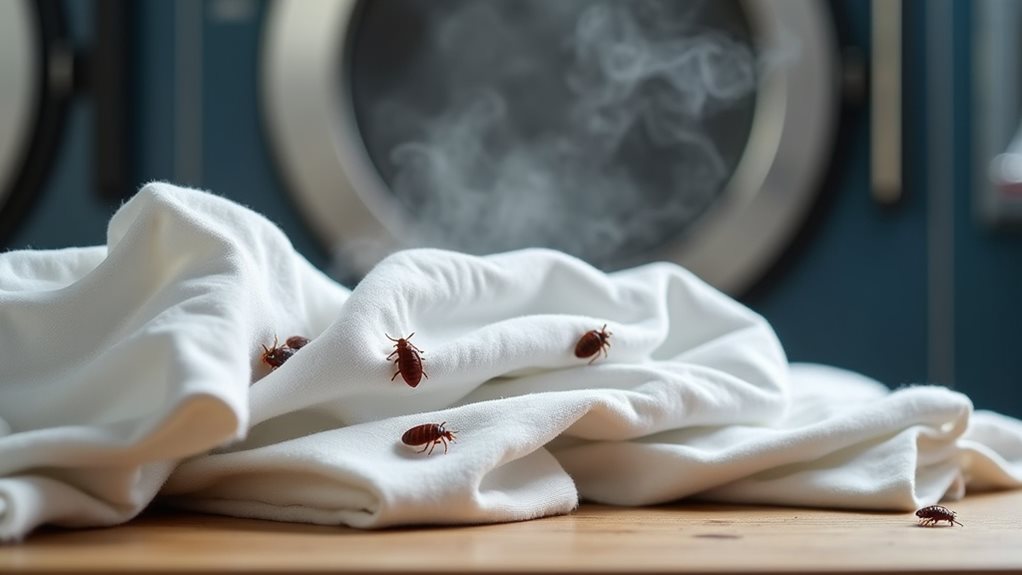
When dry cleaning disappoints you like a soggy campfire on a rainy weekend, it’s time to explore battle-tested alternatives that actually pack the punch you need against these relentless invaders 🔥.
While dry cleaning’s chemical solvents might tackle some bugs in your infested laundry, the cleaning process won’t eliminate bed bugs hiding throughout your home.
Heat treatment emerges as your strongest ally, where professionals raise temperatures above 113°F to kill bed bugs effectively.
A professional pest control company can deliver targeted insecticide applications that disrupt their nervous systems, something your neighborhood dry cleaner simply can’t match.
For severe bed bug infestations, combining multiple approaches—steam cleaning, vacuuming, and professional treatments—creates the thorough strategy you need to reclaim your peace of mind.
If you do choose dry cleaning for infested items, allow garments to air out thoroughly before wearing them since PERC residues can remain on clothes and pose health risks including skin irritation and respiratory issues.
Preventing Bed Bug Infestations at Laundromats and Dry Cleaners
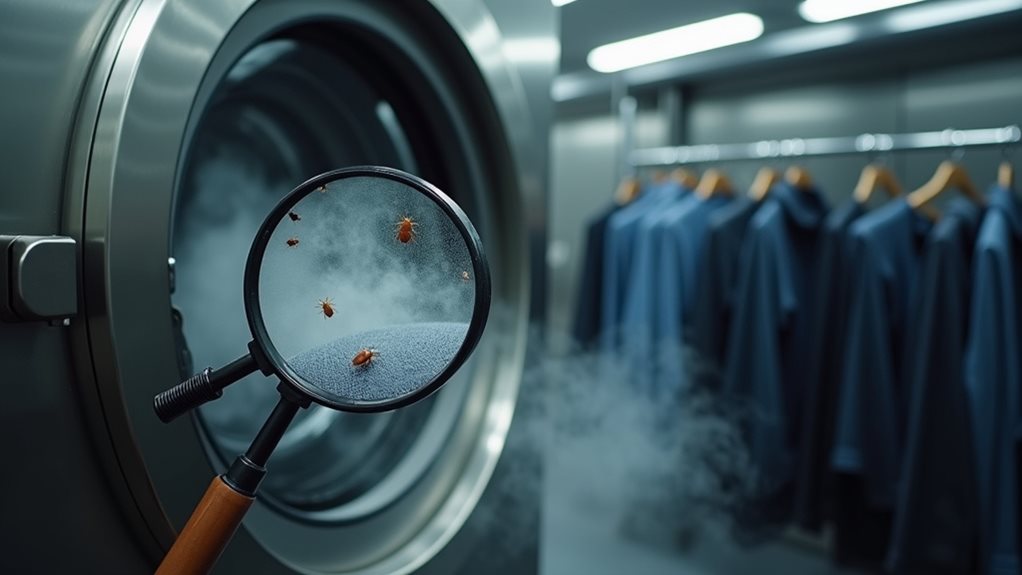
Your laundromat visits shouldn’t feel like traversing a minefield, but the reality is that these communal spaces can become unexpected breeding grounds for bed bug hitchhikers looking for their next free ride home 🎒.
To prevent bed bugs from turning your clean clothes into their personal Uber, you’ll need to transport dirty laundry in sealed plastic bags, which creates a protective barrier against potential infested clothes from other customers.
Here’s your survival strategy:
- Conduct a thorough visual inspection of baskets, carts, and seating before use
- Use high heat settings in dryers to eliminate bed bugs effectively
- Fold laundry at home instead of on communal surfaces
While cleaning solvents can’t replace proper prevention, these simple steps will help you avoid a bed bug infestation. If you do choose dry cleaning services, be aware that traditional dry cleaning chemicals like perchloroethylene can pose health risks, so allow freshly cleaned garments to air out before wearing to minimize chemical exposure.
Comprehensive Strategies for Complete Bed Bug Eradication
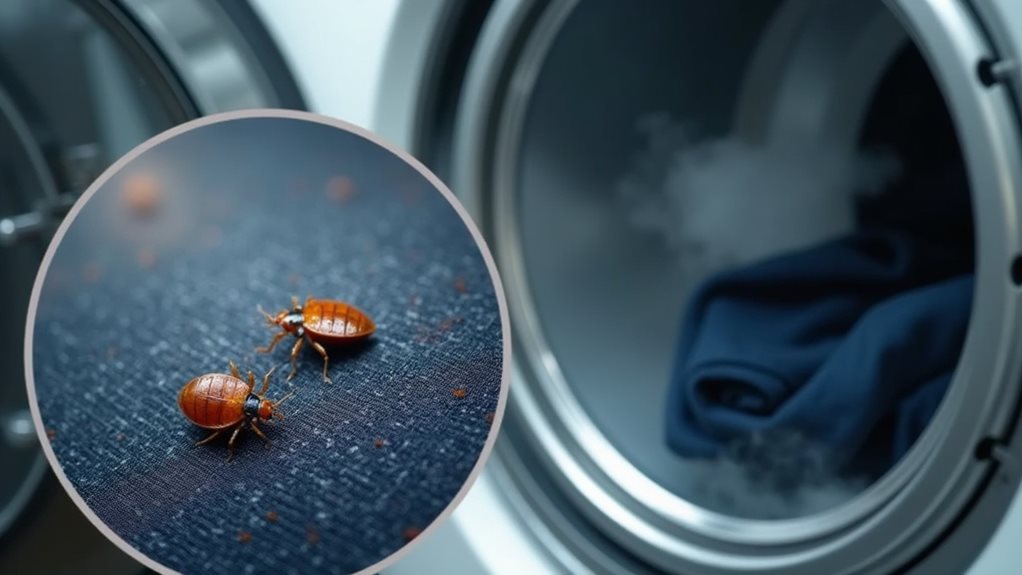
While dry cleaning can certainly knock out adult bed bugs, thinking it’s your silver bullet for complete eradication is like believing a single antibiotic pill will cure pneumonia – you’re setting yourself up for disappointment and a potential comeback tour from these persistent pests 🎭.
Your bed bug problem demands an all-encompassing strategy that goes beyond what dry cleaning solvents can accomplish alone.
Professional pest control services bring thorough inspections and multi-pronged approaches that tackle every life stage of these sneaky invaders.
Heat treatments reach lethal temperatures that eggs can’t survive, while targeted insecticides disrupt their breeding cycle.
Don’t forget protective casings for your mattress and regular vacuuming – eliminating bed bugs requires patience, persistence, and admitting that effective cleaning sometimes means calling in the cavalry.

